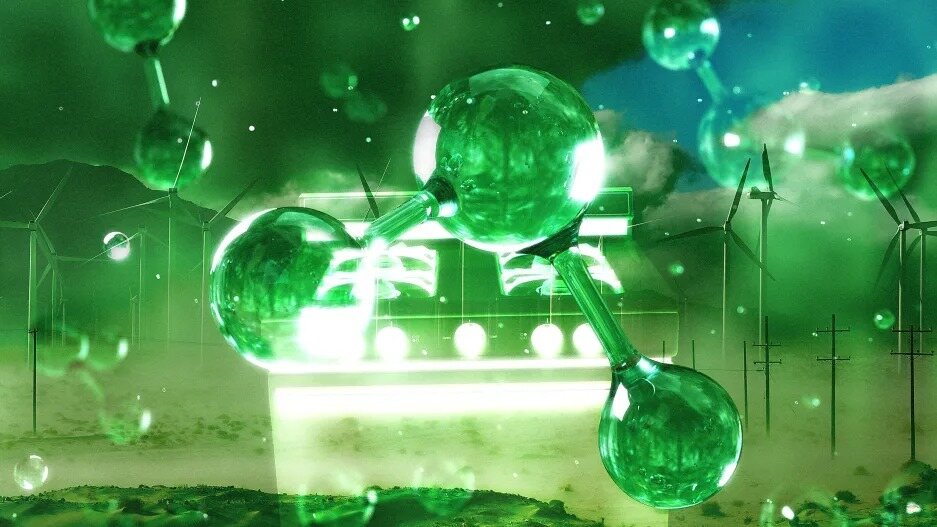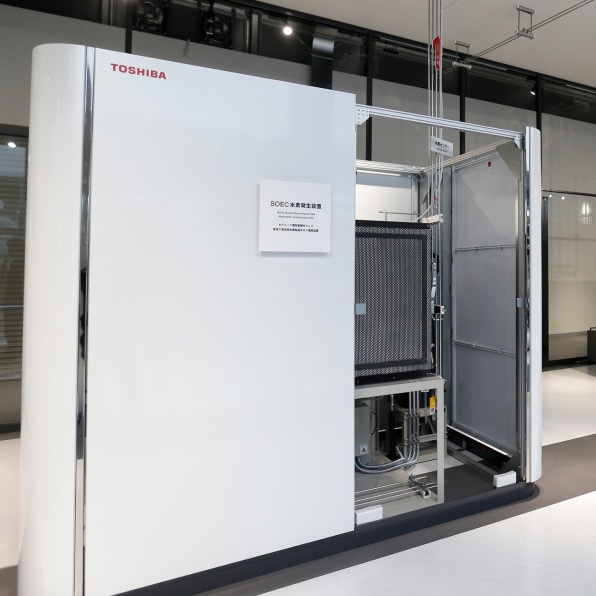- | 9:00 am
The problem with green hydrogen
Green hydrogen might be a solution for some industries, but for home power experts say it doesn’t make much sense.

If you live in Minneapolis and have gas heat or a gas stove, you might have a little bit of hydrogen flowing through your pipes. CenterPoint Energy, the local gas utility, started injecting a small percentage of hydrogen into its natural gas supply for some customers a year ago. In a small white unit on the site of a former coal gas plant near the city’s downtown, it turns electricity into hydrogen for the project.
The company points to the technology as a way to help cut climate emissions as it scales up, and across the country, utilities have proposed more than two dozen other hydrogen pilots, at both gas and electric utilities. Burning hydrogen doesn’t emit CO2. If it’s made with renewable electricity—so-called green hydrogen—producing it also doesn’t emit greenhouse gases. But environmental groups argue that it’s not the right answer.

“Using hydrogen as a fuel will needlessly prolong the life of natural gas infrastructure with minimal climate benefits and serious safety risks,” says Oakley Shelton-Thomas, a researcher at Food & Water Watch, a nonprofit that recently published a report summarizing some of the issues. “I think that hydrogen is a distraction from the alternatives—namely, renewable electricity.”
The first challenge: In existing infrastructure, it’s possible to use only a small amount of hydrogen in a blend before the safety risks become too great. Because it’s not feasible to switch to 100% hydrogen as a replacement for gas—and because hydrogen is inefficient—the total reduction in emissions will be fairly minimal.
“Trying to move beyond 20% [hydrogen] is where you run into some really serious issues,” says Dan Esposito, a policy analyst at the climate and energy think tank Energy Innovation. To be compatible with hydrogen, pipelines would have to change, as would all appliances in homes. And those types of appliances don’t even exist yet.
“It’s so difficult to get consumers to replace appliances to begin with, let alone every single one,” Esposito says. “And if you miss one—if you switch to 50% or 100% hydrogen and you still have a gas-burning appliance, you’d be talking about potential explosions. It just really gets out of hand fast.”
It also would be prohibitively expensive to replace the hundreds of thousands of miles of existing gas pipelines and more than 2 million miles of distribution lines. Most gas mains and service lines are made from plastic; because hydrogen is a small molecule and requires higher pressure to move than natural gas, it can leak through pipeline walls or fittings more easily. In longer transmission lines made from steel, hydrogen can make the metal more brittle and likely to crack.
While gas uses an odorant to help give people the ability to smell gas leaks, it’s not physically possible to add an odorant to hydrogen. Meanwhile, hydrogen is 14 times as flammable as gas; a fire can be sparked by static electricity. And even though hydrogen doesn’t emit CO2 when it’s used, if it were to leak from a pipeline it would cause reactions in the atmosphere that add to global warming.
CenterPoint Energy is using only up to 5% hydrogen in its pilot, an amount that Esposito says is likely safe. But that also means that there’s limited climate benefit. Even with 20% hydrogen, overall emissions would drop by only 6% to 7%, because hydrogen produces less energy than natural gas when it’s burned. And although costs are decreasing, it’s also expensive to make.
An Energy Innovation report sums up the problem: “Hydrogen blending investments risk wasting time and ratepayer money en route to achieving minimal GHG emission reductions, only to face daunting financial and logistical roadblocks to achieving higher blends or a 100% green hydrogen fuel network.”
To slash climate emissions from homes and other buildings, the report says, it’s more efficient to electrify: Heat pumps and induction stoves make more sense than appliances running on hydrogen. (Gas utilities could also reduce more emissions immediately by fixing methane leaks and helping people insulate their homes.)
Some utilities want to use hydrogen at electric power plants. In theory, hydrogen could be used for long-term storage of renewable energy. Currently, utilities can use batteries to store solar power generated during the day so that it can go on the grid at night, but it’s not economical to store it over long periods. Green hydrogen made from renewables could store energy seasonally, so solar power that’s generated during the summer could later be used in, say, February.
If hydrogen were made from renewable energy only when excess power is available—in California, for example, there’s often so much extra solar power in the middle of the day that it goes to waste—that could potentially be helpful. But if proposed projects make hydrogen at times when the electricity could have gone directly to homes, that’s not a good use of renewables. That scenario is more likely to happen when power plants want to use a mix of hydrogen and natural gas.
“If you’re using 80% natural gas and 20% hydrogen in your gas turbine, that’s not really serving the storage purpose that hydrogen is meant to use,” Esposito says. “Instead of using wind and solar directly, you might end up losing 30% of it by making hydrogen through electrolysis. Then you burn it at a power plant, which loses another 50% to 70% of the energy.”
In Utah, one large project that plans to produce and store green hydrogen for the electric grid will install gas units that can initially use 30% hydrogen and transition to 100% hydrogen “as technology improves,” according to its operators. But it’s not clear how long that transition will take. It’s better, Esposito argues, to focus research and development on power plants that are specifically designed to run fully on hydrogen. But even that presents issues.
In Los Angeles, for example, the local utility plans to replace its largest gas-fired power plant with turbines that burn hydrogen. When the new technology is installed, by the end of the decade, the utility wants to use the facility for backup power when there isn’t enough renewable energy available on the grid. The utility says it wants to use 100% green hydrogen but admits that at first the hydrogen might come from other sources; right now, almost all hydrogen is produced from fossil fuels.
Community members have protested the potential safety risks and the fact that burning hydrogen—whether it’s “green” or not—can produce smog-forming nitrous oxide pollution. (While there are ways to burn hydrogen with less of this pollution, and there’s tech to help capture the pollution at power plants, it’s not yet clear how well either would work.) Hydrogen production also requires large amounts of water, which is another problem in areas that struggle with drought.
Green hydrogen could play more of a role in other industries, Esposito says. Cargo ships could run on hydrogen (one fully hydrogen-powered ship will soon begin service on inland waterways in the Netherlands). Long-distance flights could run on hydrogen. Steel plants could use hydrogen. But for most domestic energy use, there are better options.
Shelton-Thomas of Food & Water Watch says that when a local utility proposes a new hydrogen project, community members should respond and share their concerns. “Many of these proposals would require approval at the local level—a local utility regulated by a local or state governance body—and they’ll require public approval for potentially expensive hydrogen projects that would be billed to consumers,” he says. “So there’s a point of resistance there as well.”






































